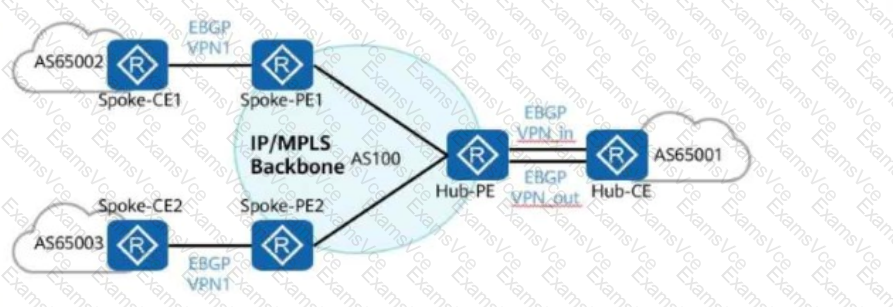Comprehensive and Detailed In-Depth Explanation:
1. Understanding the Hub-Spoke BGP Design
Hub-Spoke topology is commonly used in MPLS Layer 3 VPNs, where:
Hub-PE acts as a central router.
Spoke-PEs connect to the hub but do not communicate directly with each other.
eBGP (External BGP) is used between the Hub-PE and Spoke-PE routers.
2. The Role of AS Numbers in BGP Route Transmission
By default, BGP prevents routes from being sent back to the same AS (Autonomous System) to avoid loops (via the AS_PATH loop prevention mechanism).
However, in a Hub-Spoke MPLS VPN, the Hub-PE must be allowed to re-advertise routes learned from one spoke to another spoke.
This requires allowing repetitive AS numbers within the same AS to avoid BGP rejecting valid routes.
3. Solution: Using "Allow-AS Loop" on the Hub-PE
The allowas-in or allow-as-loop command must be used on Hub-PE to allow repetitive local AS numbers.
This ensures that routes from Spoke-PE1 (AS65002) are advertised to Spoke-PE2 (AS65003) via Hub-PE, even if AS numbers are repeated.
Example Configuration on Hub-PE:
plaintext
CopyEdit
bgp 65001
peer Spoke-PE1 allow-as-loop 2
peer Spoke-PE2 allow-as-loop 2
4. Evaluating the Answer Choices
Option
Correct?
Reasoning
A. TRUE
✅ Correct
Hub-PE can be configured to allow repetitive AS numbers using the allow-as-loop feature.
B. FALSE
❌ Incorrect
BGP by default prevents repeated AS numbers, but this can be overridden.
✅ Correct Answer: A. TRUE
Final Conclusion:
By default, BGP prevents AS loopbacks.
Hub-PE needs to allow repetitive AS numbers for proper route transmission in the hub-spoke model.
The "allow-as-loop" command enables this functionality.
Thus, the correct answer is: TRUE.
[Reference:, HCIP-Datacom-Advanced Routing & Switching Technology V1.0 – BGP AS-Path Handling, Huawei Official HCIP-Datacom Study Guide – MPLS Hub-Spoke VPN and AS Loop Prevention, Huawei Documentation on BGP allow-as-loop Command, , , , ]




